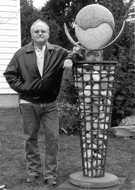No Pressure Compressor Buying - March/Apr 2008
- Details
- Created: Sunday, 02 March 2008 05:40
Ed Note: You may remember a question that circulated on the NWSSA email asking about power, tank size and general information by someone wanting to buy an air compressor. In case you didn’t write down all the good information Ken Barnes gave in his reply, here’s your hard copy.
CFM (cubic feet per minute) is the key. I wouldn't worry about psi (pounds per square inch), since they will all supply more than you need and you will have to dial them down a bit to the 65 or so recommended for air hammers. You can look at the tool manual to see what cfm they recommend, but I would guess that it is less than 8. In my experience I would guess that you could get by with a 3 hp (horse power) compressor, although cfm should be the real thing you look at. You will note that the compressors sold in the Home Depots of the world use "peak" hp, which is based upon the current they draw upon startup and is just a marketing thing to make their machines look twice as strong as they really are. The real hp they use will be about half of their "peak" hp. On the other hand, if you are buying a real industrial compressor the hp will be accurately rated. The formula for checking is amps times volts times the motor efficiency divided by 746 to get real hp (you can use about 95% for efficiency and get close enough).
A larger tank helps to buffer the demand, and lets you run a smaller motor. For example, if you have a large tank, are putting out 5 cfm but using 6 cfm, the tank will be able to supply you enough as long as you are not running the hammer about 20% of the time. If your motor can supply enough cfm for your use then technically you could do without a tank entirely, although it is nice to have at least a small one.
The consumer versions typically run their motors at double speed to get more cfm out of a smaller motor, which makes it much louder and wears it out more quickly. However, if you are like most of us and are not using this 8 hours per day 5 days a week the cheapness of the consumer versions more than offsets the loudness and falling apart factors, because it will still last several years or more.



